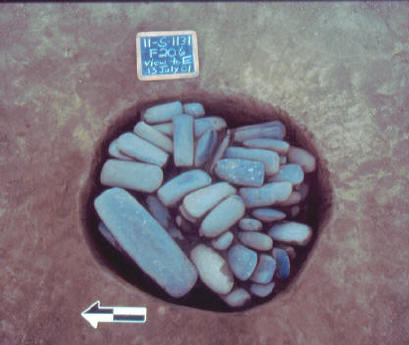

Follow Larry with every step of his
reproduction of  the large Grossman celt.
Larry wishes to thank the University of Illinois, Champaign-Urbana, and Dr.
Tim Pauketat for this slide of the Grossman cache. This large cache of 70
Lohman Phase celts was discovered on Friday the, 13th of July, 2001, in
Shiloh, Illinois. The largest celt in the cache is about 18 inches long. It is
the celt Larry will try to replicate. Check in every now and then to see
Larry's progress.
the large Grossman celt.
Larry wishes to thank the University of Illinois, Champaign-Urbana, and Dr.
Tim Pauketat for this slide of the Grossman cache. This large cache of 70
Lohman Phase celts was discovered on Friday the, 13th of July, 2001, in
Shiloh, Illinois. The largest celt in the cache is about 18 inches long. It is
the celt Larry will try to replicate. Check in every now and then to see
Larry's progress.
Note; Since the spall is so heavy, Larry had to weigh it in pounds. Other aspects of the replication will be metric weights.
This is the
first chert hammer Larry will use for the pecking process.![]() It's a piece of raw Crescent Quarry Burlington. Now, it's all just muscles and
sweat.
It's a piece of raw Crescent Quarry Burlington. Now, it's all just muscles and
sweat.
Here, Larry works
on the celt bit with the chert hammer.
You can see his stop watch on the bucket next to him. Larry will use the stop
watch and clock himself in or out when he gets a phone call, needs a bathroom
break, or just needs to rest. He has a clipboard to his left where the exact
times are recorded so he knows exactly how long tasks take. Also notice the debitage at Larry's feet. In the early stages using the chert hammer, many chert
flakes spall off turning the chert into a ball, eventually. Although lots of
chert is wasted the resharpened protrusions on the chert ball aid in the pecking
process.
This is after
2hrs.-4min.-53 sec. of pecking.
![]() The celt is starting to take shape. Notice that we're at 30.6 lbs. on the celt.
The celt is starting to take shape. Notice that we're at 30.6 lbs. on the celt.
![]() (the
weight in this photo is incorrect)
Also note the debitage at this early stage. There's lots of chert debitage from
the hammer flaking off. This resharpens the hammer and allows for easier removal
of the basalt. In our area chert is abundant, therefore, this loss is
acceptable. In other flint "poor" areas other strategies may apply.
(the
weight in this photo is incorrect)
Also note the debitage at this early stage. There's lots of chert debitage from
the hammer flaking off. This resharpens the hammer and allows for easier removal
of the basalt. In our area chert is abundant, therefore, this loss is
acceptable. In other flint "poor" areas other strategies may apply.
The measurements at this point are 21-1/4"(54cm.) by 8-5/8"(22cm.)
Add the 9 min.-7secs. of hammer work to the 2hrs.-4min.-53sec. of chert pecking and you come up with a grand total of 2hrs.-14min. at this point (16/Jan/04).
This is the
debitage at the 2hr.-14min. point(410.7 grams).
![]() (the
weight in this photo is incorrect) Note the
large amount of chert flakes. This is typical of the early stages which
deteriorate the chert until it shapes to a ball.
(the
weight in this photo is incorrect) Note the
large amount of chert flakes. This is typical of the early stages which
deteriorate the chert until it shapes to a ball.
![]() Here's a chert hammer from an archaeological site near Larry's home. The site is
now a golf course. Compare this hammer with the one Larry is using.
Here's a chert hammer from an archaeological site near Larry's home. The site is
now a golf course. Compare this hammer with the one Larry is using.